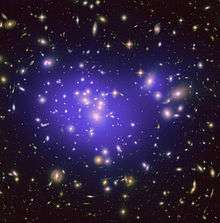Abell 1689
| Abell 1689 | |
|---|---|
|
Hubble view of galaxy cluster Abell 1689. It combines both visible and infrared data, with a combined exposure time of over 34 hours.[1] | |
| Observation data (Epoch J2000) | |
| Constellation(s) | Virgo |
| Right ascension | 13h 11m 34.2s[2] |
| Declination | −01° 21′ 56″ |
| Richness class | 4[3] |
| Bautz-Morgan classification | II-III[3] |
| Redshift | 0.1832[2] |
| Distance (co-moving) |
754 Mpc (2,459 Mly) h−1 0.705[2] |
| X-ray flux | (14.729 ± 8.1%)×10−11 erg s−1 cm−2 (0.1—2.4 keV)[2] |
| See also: Galaxy groups, Galaxy clusters, List of galaxy clusters | |
Abell 1689 is a galaxy cluster in the constellation Virgo nearly 2.2 billion light years away. It is one of the biggest and most massive galaxy clusters known and acts as a gravitational lens, distorting the images of galaxies that lie behind it.[4] It has the largest system of gravitational arcs ever found.[5]
Abell 1689 shows over 160,000 globular clusters, the largest population ever found.[6]
There is evidence of merging and gases in excess of 100 million degrees.[5] The very large mass of this cluster makes it useful for the study of dark matter and gravitational lensing.[7][8]
At the time of its discovery in 2008, one of the lensed galaxies, A1689-zD1, was the most distant galaxy found.[9][10]
Gallery
-

Yellow galaxies belong to the cluster itself. Red and blue are background galaxies gravitationally lensed.
-

Mass map of Abell 1689.
-

Globular clusters in Abell 1689
See also
References
- ↑ "New Hubble image of galaxy cluster Abell 1689". ESA/Hubble Press Release. Retrieved 14 September 2013.
- 1 2 3 4 "NASA/IPAC Extragalactic Database". Results for Abell 1689. Retrieved 2012-03-17.
- 1 2 Abell, George O.; Corwin, Harold G., Jr.; Olowin, Ronald P. (May 1989). "A catalog of rich clusters of galaxies" (PDF). Astrophysical Journal Supplement Series. 70 (May 1989): 1–138. Bibcode:1989ApJS...70....1A. doi:10.1086/191333. ISSN 0067-0049. Retrieved March 12, 2012.
- ↑ Falcon-Lang, Howard (19 August 2010). "Fate of Universe revealed by galactic lens". BBC News. BBC. Archived from the original on 19 August 2010. Retrieved 19 August 2010.
- 1 2 "Purple Haze, Part Deux". NASA. 12 September 2008. Retrieved 19 September 2012.
- ↑ "Globular clusters within Abell 1689". HUBBLE/ESA. 12 September 2013. Retrieved 19 September 2013.
- ↑ "Detailed Dark Matter Map Yields Clues to Galaxy Cluster Growth". NASA. 11 December 2010. Retrieved 19 September 2012.
- ↑ Diego, Jose M.; Broadhurst, T.; Benitez, N.; Umetsu, K.; Coe, D.; Sendra, I.; et al. (2014). "A Free-Form Lensing Grid Solution for A1689 with New Multiple Images". MNRAS. 446 (1). arXiv:1402.4170
 . Bibcode:2015MNRAS.446..683D. doi:10.1093/mnras/stu2064.
. Bibcode:2015MNRAS.446..683D. doi:10.1093/mnras/stu2064. - ↑ "Astronomers Eye Ultra-Young, Bright Galaxy in Early Universe". nasa.gov. 2008-02-12. Retrieved 2008-02-25.
- ↑ "Astronomers Uncover One of the Youngest and Brightest Galaxies in the Early Universe". Space Telescope Science Institute Baltimore, Md. / nasa.gov. 2008-02-12. Archived from the original on 17 February 2008. Retrieved 2008-02-25.
External links
| Wikimedia Commons has media related to Abell 1689. |
- Galaxy cluster Abell 1689: Biggest 'Zoom Lens' in Space Takes Hubble Deeper into the Universe (HubbleSite)
- Galaxy cluster Abell 1689: Astronomers Find One of the Youngest and Brightest Galaxies in the Early Universe (HubbleSite)
- Astronomers take a step towards revealing the Universe's biggest mystery, ESA/Hubble Press Release.
Coordinates: ![]() 13h 11m 34.2s, −01° 21′ 56″
13h 11m 34.2s, −01° 21′ 56″
